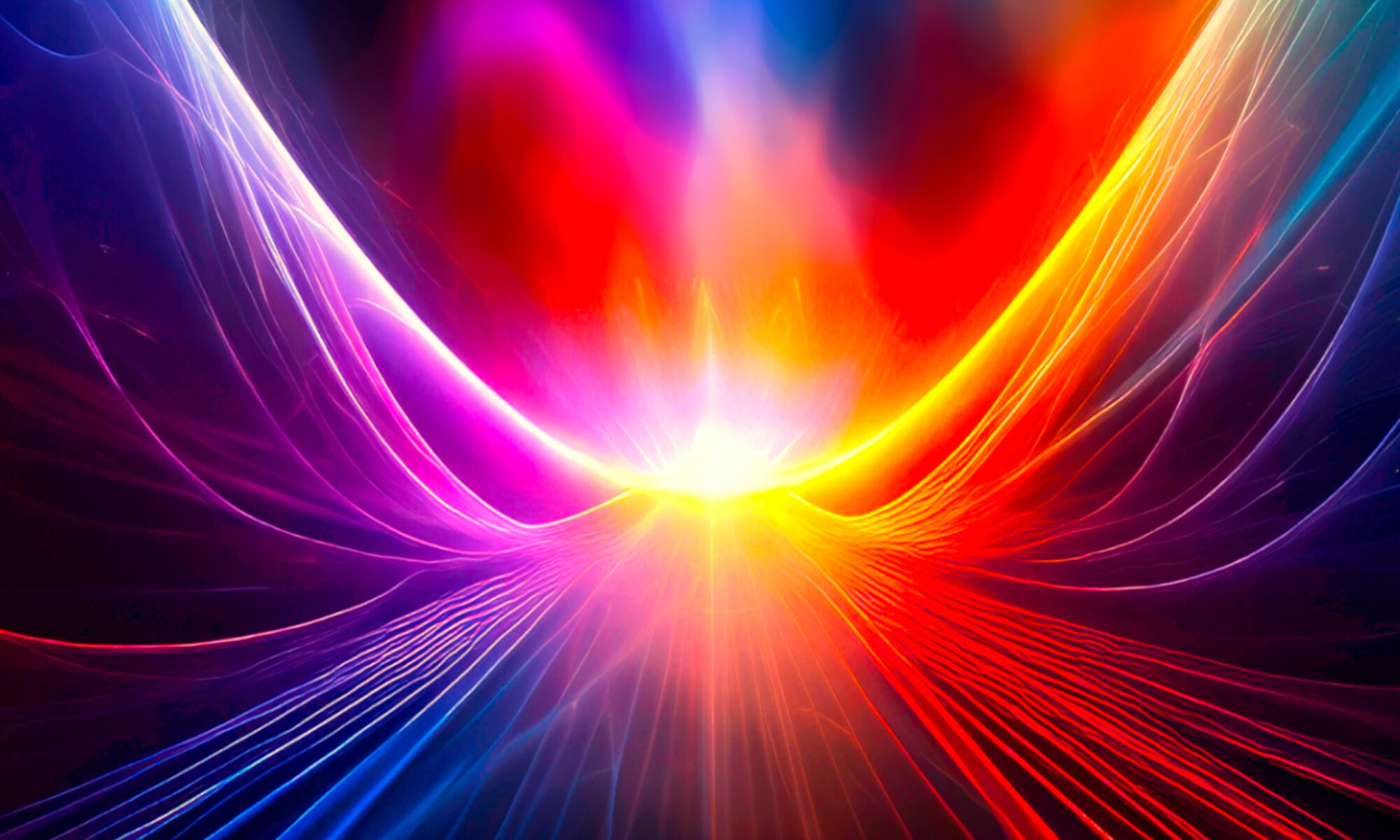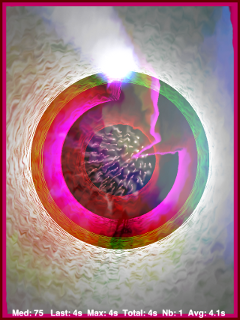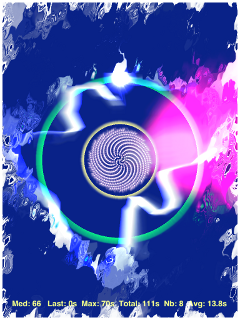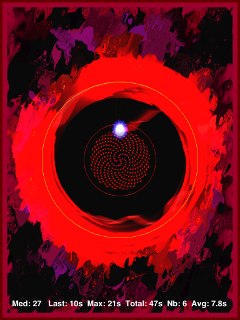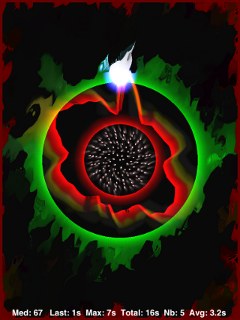About the “Art of Zen”
Letting go, being in a calm and balanced state is an extremely beautiful inner experience. What if you could visualize this supreme state of consciousness? The Art of Zen application does exactly this. It measures your inner Zen level with the help of the NeuroSky biofeedback system. It then transforms this information into dynamic flowing colors.
The Art of Zen helps to stabilize a fully aware yet meditative state. Various sounds signal when you are entering certain levels of meditation.
The Art of Zen helps to stabilize a fully aware yet meditative state. Various sounds signal when you are entering certain levels of meditation.
The Zen Level
In Zen it is never about achieving, rather it is about being fully present in the now. So the Art of Zen aims to be playful, instead of about high scores or competition. Creating beautiful graphics just by changing intentionally your inner state of mind is very fulfilling in itself. Yet it is also very interesting to have some objective measurement of your inner state.
Here is a schematic view of how your Zen level is used to create the graphics, sounds and statistics. You might well skip this information if you just want to go for the experience.
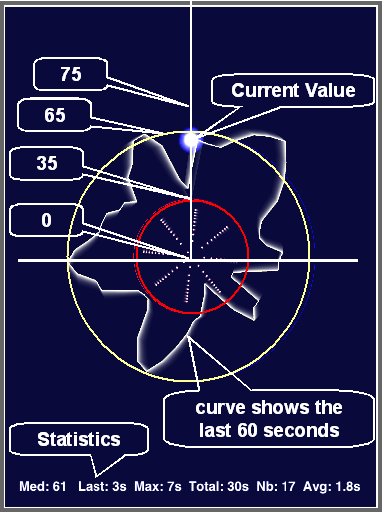
The biofeedback device constantly transmits a value between 0 and 100, where 100 represents the deepest state of meditation and 0 represents high agitation. The Art of Zen averages the last 3 seconds of input and displays it as a blue/white ball of light along the vertical axis
The red circle represents the Zen level of 35. Whenever you fall below that level the graphic alerts you and a gong sound is played. That level usually means you are caught in your thoughts – hence it is time to let them go. In Zen terminology this state is called Sanran.
The yellow circle represents the 65 Zen-level. It symbolizes a state of solid inner meditation, called Samadhi in the world of Zen. Once you cross that threshold, the graphic changes – stay relaxed, do not get distracted, even if you are witnessing beauty.
The 75 Zen-level is not visualized. If you cross it, the graphic once again changes its characteristics.
Each new meditation value is fed into the curve that is wrapped around the center. This allows you to easily see your Zen level over the last 60 seconds. Those portions of the curve that reach into the Samadhi zone are used to create the dynamic graphics.
Various statistics are displayed at the bottom of the screen, which give you objective feedback of your current session at a glance.
| Med: | Your current meditation level (Zen level) |
| Last: | The number of seconds you stayed in the Samadhi zone (above the 65 level) the last time you entered into it. |
| Max: | The longest amount of time in seconds you have stayed in the Samadhi zone. |
| Total: | The total amount of time in seconds you spent in the Samadhi zone. |
| Nb: | The number of times you entered the Samadhi zone |
| Avg: | The average duration in seconds of your visits to the Samadhi zone. |
The Art of Zen with Eyes Closed
If you want to go for a pure meditation session just close your eyes and take advantage of the Art of Zen’s sounds. Whenever you enter or leave the Samadhi zone (above 65) or the Sanran zone (below 35) you are notified by a sound.
Actually, in true Zen meditation you do not close the eyes fully. Instead they are kept a little bit open, but without you looking outward. Having the eyes slightly open permits some light to enter making it much easier not to get tired or carried away by dreams and mental clutter.
Visualization of Eye blinks and Sound

An eye blink results in a light ball emerging from the center illuminating the current graphics. The strength of the eye blink determines the angle in which the light ball travels.
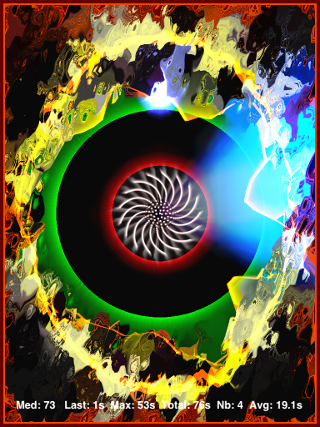
Making a sound, such as humming, toning, or singing, creates an additional animated circle.
Using the “Settings” application of your iOS device you can turn the eye blink and sound visualization options on and off.
The Inner Galaxy

In the center of the graphics you see a rotating galaxy of tiny stars. This galaxy constantly changes its appearance.
Moreover, with every second spent in the Samadhi zone 5 stars are added which enrich the graphics.
For every second spent in the Sanran zone 5 stars are removed.
Creating Screenshots on iPad
You might use iPad’s general feature of creating screenshots by quickly pressing the Home and the On/Off buttons simultaneously. The screenshot is saved to your photo gallery.
NeuroSky’s MindWave Headsets

“Art of Zen” for iOS requires NeuroSky’s “MindWave Mobile” or” MindWave Mobile-Plus” headset to be connected.
The PC version works with the” MindWave” and” MindWave Mobile-Plus” headsets.
For more information and ordering info visit www.neurosky.com.
A note for Zen pros
In Zen meditation, also known as Zazen, it is about being fully aware of the current moment. Whatever shows up – a thought, picture, emotion, even Buddha himself – it is continually released. However, there is this very subtle moment of transition where one goes from being fully present into following one’s thoughts. The earlier this moment is recognized the easier it is to stay aware. The Art of Zen helps one to recognize the particular moment this transition begins. Apart from observing the beautiful graphics, this is a highly interesting area to explore.
See Also
Have a look at “The Beauty Within” which also relies on the NeuroSky headset.
Fluid Light Engine
The Art of Zen is built with Joachim’s Fluid Light Engine.
